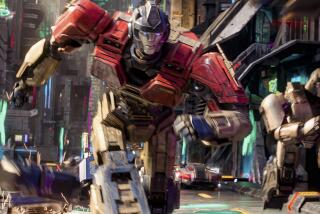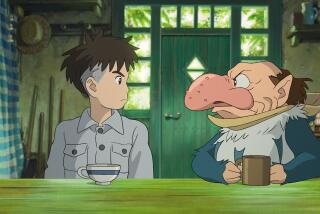‘Toy Story 4’ director Josh Cooley was 15 when he saw the first movie. Now, he’s in charge
- Share via
In 1995, a 15-year-old aspiring cartoonist named Josh Cooley walked into a movie theater in his hometown of Livermore, Calif., bought a ticket to a much-buzzed-about new animated film called “Toy Story” and had his mind forever blown to infinity and beyond.
“I had always wanted to be in animation for as long as I could remember,” Cooley says. “But it was unlike anything I’d ever seen.”
The first feature film to be entirely computer-animated, “Toy Story” was unlike anything anyone had ever seen, and the movie’s success would kick off a beloved trilogy and set the template for all of Pixar Animation Studios’ smashes to follow. Now, 24 years later, that onetime would-be cartoonist whose career path was shaped in part by Sheriff Woody and Buzz Lightyear has inherited the keys to the toy chest as the director of “Toy Story 4.”
“Toy Story 4,” in theaters June 21, arrives nearly a decade after 2010’s “Toy Story 3” put what many thought would be the final punctuation mark on a series that has grossed nearly $2 billion worldwide and earned a slew of Oscars. The film sets Woody and his plaything friends off on a fresh adventure when their new owner, Bonnie, creates an arts-and-crafts toy she names Forky. As Woody tries to save Forky from an existential crisis, he is reunited with lost love Bo Peep in a local antique shop and finds his way toward a new purpose in life.
Even as it brings together familiar characters including Woody (voiced by Tom Hanks), Buzz (Tim Allen) and Bo Peep (Annie Potts) with new ones including Forky (Tony Hale), stunt-motorcyclist action figure Duke Caboom (Keanu Reeves) and plush-toy duo Ducky and Bunny (Keegan-Michael Key and Jordan Peele), “Toy Story 4” unites two generations of Pixar talent. Key players at the studio who originally brought the franchise to life, including Andrew Stanton and Pete Docter, have teamed up with people like Cooley who grew up with the “Toy Story” movies.
REVIEW: ‘Toy Story 4’ grows up but still keeps the joy of toys »
“This movie definitely bridged that gap,” says the 39-year-old Cooley, who is making his feature debut with the picture. “We had people on this film that worked on the original ‘Toy Story,’ like my production designer Bob Pauley, who designed Buzz Lightyear. Then we have artists on this film that actually showed us pictures of themselves when they were 6 years old dressed as Buzz Lightyear for Halloween.”
“Toy Story 4” producer Jonas Rivera had been a newly hired intern at Pixar in 1994 when “Toy Story” was in its last year of production. “Pixar was in its infancy — it was pretty small, like 150 people — and I was working the production desk getting coffees and lunches,” Rivera says. He laughs. “When I met Tom for our first session with him on this film, he said, ‘Haven’t I met you?’ I said, ‘Well, way back on the first one I brought you a cup of coffee. Would you like a cup of coffee now?’ ”
For Docter, who was a writer and head animator on the first “Toy Story” and now serves as chief creative officer of Pixar, it’s heartening to see the torch being passed to a younger generation that can continue to drive innovation. “It’s a great blend of new and old,” Docter says. “All the knowledge and wisdom that we painfully, slowly accrued over many years, and then a bunch of new people who don’t know why you can’t do it — and they do it anyway.”
In wake of “Toy Story 3,” which ended with an air of finality when the toys’ owner, Andy, went off to college, few expected the franchise to continue. But even before the film was released, Stanton — who has had screenplay or story credit on every “Toy Story” movie — quietly started discussing ideas for where the series could potentially go with fellow Pixar brain trust members John Lasseter, Docter and “Toy Story 3” director Lee Unkrich.
RELATED: ‘Toy Story 4’ finds the lost and toughened-up Bo Peep, plus a flock of new characters »
Eventually, they settled on the notion of bringing back the porcelain figurine Bo Peep, who was most prominent in the original “Toy Story” but absent from “Toy Story 3,” as a helper of lost toys who could guide Woody toward his next chapter.
“Andrew, John, Pete and Lee kind of had a pact that they didn’t want to put an idea forward for a ‘Toy Story 4’ if they didn’t all agree that it was the right thing to do,” says producer Mark Nielsen. “The [project] always had Bo Peep at its core. The code name we had for it inside the studio from the very beginning was ‘Peep.’ ”
Having worked his way up through the Pixar ranks, first as a storyboard artist on films including “Cars” and “Ratatouille” and then as a writer on “Inside Out” and the director of the short “Riley’s First Date,” Cooley was initially brought on to co-direct “Toy Story 4” with Lasseter, who had directed the first two films in the series. But in July 2017, Lasseter announced he was stepping away from directing to focus on his executive responsibilities at Pixar and Walt Disney Animation Studios. Later that year, after allegations of sexual misconduct surfaced against him, Lasseter took a leave of absence. He left Pixar and Disney at the end of 2018, though he retains a story credit on “Toy Story 4.”
For Cooley, learning he was assuming the directing reins of the film on his own was a shock to the system. “I was being pushed out of the nest,” he says. “I remember my vision kind of being blurry and the sound going mute a little bit. It was an out-of-body experience. But I never thought of saying no.”
For the “Toy Story 4” creative team, fleshing out a story that would feel like a natural continuation of the saga and not simply an afterthought — or, worse, a cynical cash grab — took time. “We said, ‘There needs to be a deeper reason to make this movie,’ ” says Rivera. “We didn’t want it to feel to the audience like, ‘Oh, we forgot a part.’ ”
RELATED: Keanu Reeves is on a roll, and ‘Toy Story 4’ is no exception »
Further complications arose when, amid the controversy over Lasseter, Rashida Jones and Will McCormack, who had been brought on to write the “Toy Story 4” screenplay, left the project in late 2017 citing “philosophical differences.”
“When I took over, we hadn’t really cracked the story completely yet,” Cooley says. “I was told by everybody, ‘Just question everything that we’ve got so far. Don’t feel like you need to hold onto anything.’ The thing that really unlocked it was when we came up with the idea of having Woody grow enough to complete his arc. He’s always been so there for a kid and he was always telling everybody, ‘That’s our job.’ To have him realize that [life] doesn’t just have to be in this bedroom, that it can be bigger than that — once we had that, we thought, ‘OK, now there’s some real juice to this story.’”
Stanton says Cooley quickly proved himself up to the job of steering the ship. “He was really nervous at first, as you would be taking on something like ‘Toy Story,’ but once he realized all of us were that nervous when we worked on the [first] one and that we understood what that was like, he was sort of able to calm down,” Stanton says. “What’s nice is we gave Josh the job for a reason. He had a different slant and a different sort of sense of humor that wasn’t us. He was able to give it that extra flavor.”
Hanks credits Pixar with nurturing younger artists like Cooley and preparing them to step out on their own. “I think all those people come up through the system there — by the time they’re actually given a chance to direct, they’ve really proven themselves over and over and over,” the actor says. “There’s always this ensemble of people that are there as guides, but he is the guy who will say, ‘OK, that’s it.’ ”
Combining the passion and energy of the younger generation with the hard-won institutional knowledge of the older one provided what Rivera calls “a creative insurance policy over the film.” “Our attitude of being around from the early ones is, ‘We have to protect the studio and make this great,’ ” he says. “Their attitude is, ‘We have to protect our childhood. We don’t want this messed up.’ ”
As for where the “Toy Story” franchise could go from here — if indeed it goes on at all — Cooley says he’s happy to let things unfold in their own time.
“There’s been no talk of a fifth movie,” he says. “For me, I feel very happy with the ending of this film. I feel like it completes Woody’s arc completely. But at same time, at Pixar we have this kind of ‘never say never’ [attitude]. Because you never know what great ideas can come about.”
Times staff writer Christina Schoellkopf contributed to this report.
RELATED: The summer’s biggest movie franchises — ranked »
Twitter: @joshrottenberg
More to Read
Only good movies
Get the Indie Focus newsletter, Mark Olsen's weekly guide to the world of cinema.
You may occasionally receive promotional content from the Los Angeles Times.











